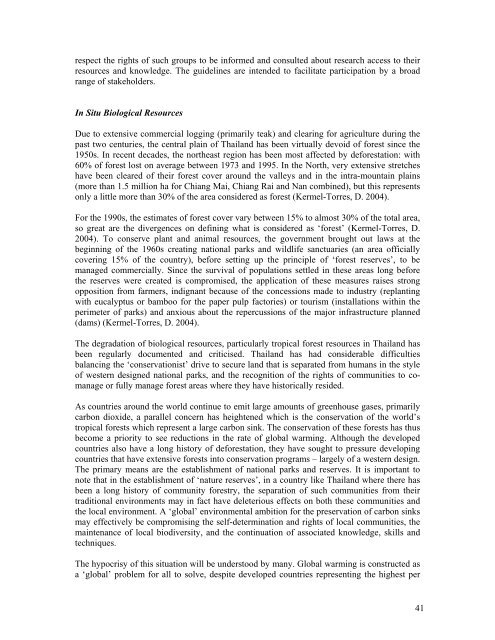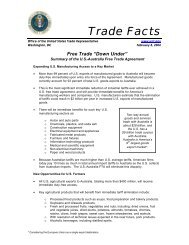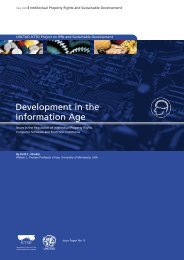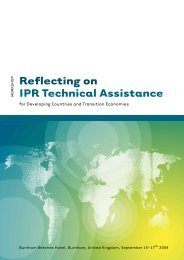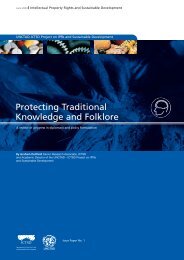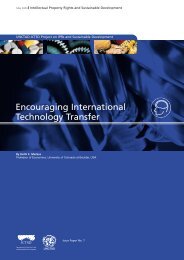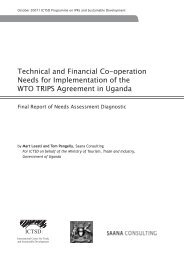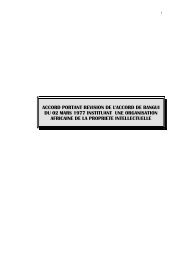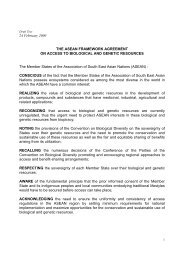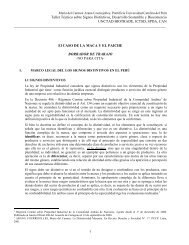Governance and Micropolitics of Traditional ... - IPRsonline.org
Governance and Micropolitics of Traditional ... - IPRsonline.org
Governance and Micropolitics of Traditional ... - IPRsonline.org
You also want an ePaper? Increase the reach of your titles
YUMPU automatically turns print PDFs into web optimized ePapers that Google loves.
espect the rights <strong>of</strong> such groups to be informed <strong>and</strong> consulted about research access to their<br />
resources <strong>and</strong> knowledge. The guidelines are intended to facilitate participation by a broad<br />
range <strong>of</strong> stakeholders.<br />
In Situ Biological Resources<br />
Due to extensive commercial logging (primarily teak) <strong>and</strong> clearing for agriculture during the<br />
past two centuries, the central plain <strong>of</strong> Thail<strong>and</strong> has been virtually devoid <strong>of</strong> forest since the<br />
1950s. In recent decades, the northeast region has been most affected by deforestation: with<br />
60% <strong>of</strong> forest lost on average between 1973 <strong>and</strong> 1995. In the North, very extensive stretches<br />
have been cleared <strong>of</strong> their forest cover around the valleys <strong>and</strong> in the intra-mountain plains<br />
(more than 1.5 million ha for Chiang Mai, Chiang Rai <strong>and</strong> Nan combined), but this represents<br />
only a little more than 30% <strong>of</strong> the area considered as forest (Kermel-Torres, D. 2004).<br />
For the 1990s, the estimates <strong>of</strong> forest cover vary between 15% to almost 30% <strong>of</strong> the total area,<br />
so great are the divergences on defining what is considered as ‘forest’ (Kermel-Torres, D.<br />
2004). To conserve plant <strong>and</strong> animal resources, the government brought out laws at the<br />
beginning <strong>of</strong> the 1960s creating national parks <strong>and</strong> wildlife sanctuaries (an area <strong>of</strong>ficially<br />
covering 15% <strong>of</strong> the country), before setting up the principle <strong>of</strong> ‘forest reserves’, to be<br />
managed commercially. Since the survival <strong>of</strong> populations settled in these areas long before<br />
the reserves were created is compromised, the application <strong>of</strong> these measures raises strong<br />
opposition from farmers, indignant because <strong>of</strong> the concessions made to industry (replanting<br />
with eucalyptus or bamboo for the paper pulp factories) or tourism (installations within the<br />
perimeter <strong>of</strong> parks) <strong>and</strong> anxious about the repercussions <strong>of</strong> the major infrastructure planned<br />
(dams) (Kermel-Torres, D. 2004).<br />
The degradation <strong>of</strong> biological resources, particularly tropical forest resources in Thail<strong>and</strong> has<br />
been regularly documented <strong>and</strong> criticised. Thail<strong>and</strong> has had considerable difficulties<br />
balancing the ‘conservationist’ drive to secure l<strong>and</strong> that is separated from humans in the style<br />
<strong>of</strong> western designed national parks, <strong>and</strong> the recognition <strong>of</strong> the rights <strong>of</strong> communities to comanage<br />
or fully manage forest areas where they have historically resided.<br />
As countries around the world continue to emit large amounts <strong>of</strong> greenhouse gases, primarily<br />
carbon dioxide, a parallel concern has heightened which is the conservation <strong>of</strong> the world’s<br />
tropical forests which represent a large carbon sink. The conservation <strong>of</strong> these forests has thus<br />
become a priority to see reductions in the rate <strong>of</strong> global warming. Although the developed<br />
countries also have a long history <strong>of</strong> deforestation, they have sought to pressure developing<br />
countries that have extensive forests into conservation programs – largely <strong>of</strong> a western design.<br />
The primary means are the establishment <strong>of</strong> national parks <strong>and</strong> reserves. It is important to<br />
note that in the establishment <strong>of</strong> ‘nature reserves’, in a country like Thail<strong>and</strong> where there has<br />
been a long history <strong>of</strong> community forestry, the separation <strong>of</strong> such communities from their<br />
traditional environments may in fact have deleterious effects on both these communities <strong>and</strong><br />
the local environment. A ‘global’ environmental ambition for the preservation <strong>of</strong> carbon sinks<br />
may effectively be compromising the self-determination <strong>and</strong> rights <strong>of</strong> local communities, the<br />
maintenance <strong>of</strong> local biodiversity, <strong>and</strong> the continuation <strong>of</strong> associated knowledge, skills <strong>and</strong><br />
techniques.<br />
The hypocrisy <strong>of</strong> this situation will be understood by many. Global warming is constructed as<br />
a ‘global’ problem for all to solve, despite developed countries representing the highest per<br />
41


